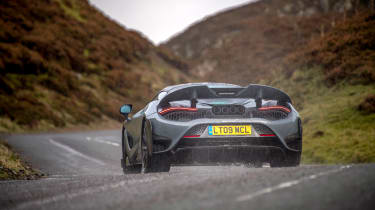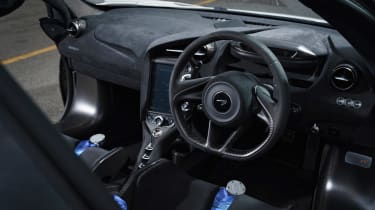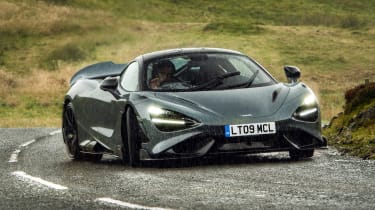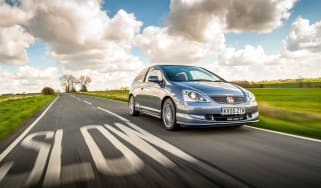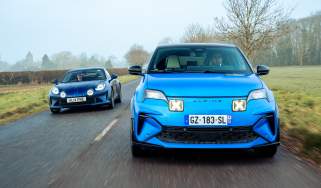McLaren 765LT (2020-2023) review – a unique and thrilling supercar experience
McLaren’s stunning 765LT fulfils its brief by pushing supercars to the next level, delivering both on road and track – just make sure you have your wits about you
The McLaren Long Tail moniker has long been applied to some of the most visceral and exciting supercars ever, whether they be from the days of Murray’s F1, or more recent editions like the 675LT and the 600LT.
But when McLaren applied the LT treatment to the eCoty-winning 720S it gave us one of its most ballistic, exciting road cars to date – the 765LT. With the 720S and its LT derivative now making way for the new 750S, McLaren has a serious task on its hands to match – or better – what was one of the greatest supercars of our time.
Look through the small porthole in the 765LT's rear deck and you’ll spot the trusty 4-litre version of McLaren’s Ricardo-built V8, here tuned to somewhere between the 720S and Senna. It takes the forged pistons and stronger head gasket from the latter, and updates the oil pump. It exhales through a titanium exhaust system, producing a huge 755bhp coupled with 590lb ft of torque. The gearbox is the usual seven-speed twin clutch unit, but the ratios have been made shorter to the benefit of acceleration. 0-62mph takes just 2.8 seconds, while the 0-124mph is a ballistic 7-seconds dead.
More reviews
Yet the fact that the 765LT has more power than the regular 720S is almost an irrelevance: a necessary inclusion to justify its standing in the range and the price tag, but arguably of secondary importance to the changes found with the LT’s aero, chassis and weight saving measures.
The car is an impressive 80kg lighter (for a DIN figure of 1,339kg) thanks to a range of measures that have stripped back weight wherever it can be. The wheels are lighter, the glazing is 0.8mm thinner (the rear window is made from polycarbonate), the floor and front and rear bumpers are carbonfibre, as is almost everything you can touch, and much of the rear of the car is open to the elements, not only to save weight but to let heat escape.
The LT produces around 25 per cent more downforce than the S, with a jutting front splitter that contributes most of the additional 48mm in the car’s length. There are side blades to manage the air, extensions behind the rear wheels to keep turbulence away from the simply enormous rear diffuser and a rear wing that sits higher in the airstream, and flips up at the rear of the blade. It also doubles as an airbrake under heavy braking.
McLaren has retained the Proactive Chassis Control 2 setup, but lowered the front by 5mm and widened the front track, and recalibrated the dampers to suit. A bespoke Pirelli Trofeo R tyre has been developed for the car, and the brake calipers from the Senna are standard fit; the Senna’s sintered carbon discs are an option, as are its very light and supportive seats.
The LT’s cabin is smothered in Alcantara, stripped back with less carpet, and entirely focused on the task of driving. That’s just as well when you stop to consider the 755bhp under your right foot, something that inevitably happens the first time you clamber into the stern embrace of the ‘Senna’ bucket seat. A five-point harness further clamps you in place, and the scaffold-work of the Clubsport package frames the view aft in the rear view mirror. The V8 pulsates through the seat, and the driving position couldn’t be any more perfect for fast driving. There is no ambiguity about the 765LT’s purpose in life – in fact, its sheer sense of focus is intoxicating.
Of course, it’s shockingly fast. On a large open track like Silverstone rarely has a car felt as though it can shrink the Hangar straight like this one. Exit onto it in fourth gear, in the meat of the powerband, and the car simply shrieks for the horizon, requiring a big stop down from over 160mph in the braking zone for Stowe. The gearshifts are virtually instantaneous, the paddles perfectly sized and situated.
The real triumph of the LT is that it can operate on many different levels. Obviously, the outer reaches of its performance envelope are ferocious, but with the aid of the sophisticated traction and stability control systems it can give you as much rope as you dare, and still be there to help you get out of trouble. Or, naturally, you can switch things right off, in which situation the LT becomes a complete hooligan on the throttle…
The sheer grip that the car can generate does take some getting used to, but once you’re dialled into this, and have the confidence to exploit the amazing braking powers afforded by the Senna setup, you can carry terrific speed through a corner and revel in the way the car rotates precisely at the point you want it to. Even the smallest throttle lift or steering input makes a huge difference to your trajectory, and what’s also deeply impressive is how the LT’s brakes and tyres stand up to repeated abuse without even the first sign of fade. It’s the sort of car once you’re lapping at speed, you really don’t want to come back into the pits.
On road, the performance it possesses is completely mind-blowing, even on roads where you’d expect it to be too low and too stiff. The stability system is brilliantly effective and tremendously flattering. There’s no need to turn it off in a road scenario. Experience made me tense and tentative on cold, damp roads, but you really can trust it implicitly. That’s bonkers when you consider what you’re unleashing through the rear wheels of a light, mid-engined car.
Yet the talking point the moment you extricate yourself from the 765LT is its steering. Its tactility, perfect weighting regardless of speed and how the calm feedback isn’t impacted by pace. It’s far too fast for the road, but due to its unmatched combination a perfect driving position, chassis balance, intuitive stability systems and that steering precision, is a masterclass of the modern supercar.
Price and rivals
McLaren built 765 examples each of the 765LT coupe and Spider at around £280,000 and £300,000 respectively. Gone are the days when Ferrari and McLaren produced direct rivals, with both shaking things up with different approaches to hybridisation. Ferrari’s 296 GTB is powered by a V6 hybrid, and a brutally impressive one at that with its immense performance and defined character. It’s not as raw or pure as the McLaren, though, and even when fitted with the optional Assetto Fiorano package that bundles some lightweight options with an expensive set of passive Multimatic dampers, still lacks the visceral edge of the McLaren.
Lamborghini’s Huracán STO is closer in terms of ethos, itself a spectacular example of a hardcore road-going special with staggering levels finely detailed communiqué. But the difference between Lambo and McLaren come in their powertrains, as the extra drama of the STO’s exotic soundtrack and responsiveness comes with a substantial drops in performance – but we did just say the McLaren was far too fast for the road.
Porsche’s new £180,000 911 GT3 RS is another consideration. With fully adjustable dampers, differential settings and stability systems it's a genuine track fiend, one that has the intensity of a pure-bred Cup car. Whatever McLaren comes up with for the 750S's hardcore derivative, it'll have quite a fight on its hands.


